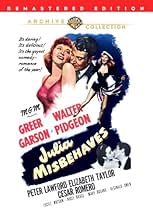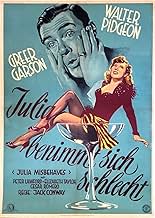Una ragazza del coro di Londra cerca di riaccendere i suoi rapporti con sua figlia che aveva abbandonato da bambina e con il suo ex marito.Una ragazza del coro di Londra cerca di riaccendere i suoi rapporti con sua figlia che aveva abbandonato da bambina e con il suo ex marito.Una ragazza del coro di Londra cerca di riaccendere i suoi rapporti con sua figlia che aveva abbandonato da bambina e con il suo ex marito.
- Mannequin
- (non citato nei titoli originali)
- Bill Collector
- (non citato nei titoli originali)
- Drunken Man
- (non citato nei titoli originali)
Trama
Lo sapevi?
- QuizDuring filming, Peter Lawford introduced Greer Garson to E.E. Fogelson, an oil-and-cattle millionaire from Texas, on this film set. Garson, who had recently been divorced from her Mrs. Miniver co-star, Richard Ney, met "Buddy," fell in love and married the next year. The marriage would last nearly 40 years until Fogelson's death.
- BlooperAfter exiting the right hand drive phaeton/touring car at the honeymoon cabin, the two couples congregate at the right driver's side; the car is facing screen right. The next scene has the caretaker approaching from the right, and the two couples are now standing in the exact same positions but on the left passenger side of the car; the car is now facing screen left.
- Citazioni
Fred Ghenoccio: I've been waiting for something like this!
William Sylvester Packett: What do you mean?
Fred Ghenoccio: I know you society swells wandering around the passages at night. Sneaking into strange bedrooms.
William Sylvester Packett: Don't be a fool. Julia's my wife.
Fred Ghenoccio: She may be your wife, but she's my fiancée!
- ConnessioniReferenced in Hollywood Hist-o-Rama: Greer Garson (1961)
I più visti
- How long is Julia Misbehaves?Powered by Alexa
Dettagli
- Tempo di esecuzione1 ora 39 minuti
- Colore
- Proporzioni
- 1.37 : 1
Contribuisci a questa pagina







































